Table of Contents |
As you have learned, life is organized into various levels: Atoms (the basic unit of all matter/chemicals) compose molecules, which compose cells (the basic unit of life), which compose tissues, which then will compose organs, which make up organ systems. Finally, organ systems make up organisms.
You will be learning more about each of the organ systems of the human body throughout this course. Below, the organ systems of humans are briefly described.
What do you think when you look at your skin in the mirror? Do you think about covering it with makeup, adding a tattoo, or maybe a body piercing? Or do you think about the fact that the skin belongs to one of the body’s most essential and dynamic systems: the integumentary system?
The integumentary system refers to the skin and its accessory structures, and it is responsible for much more than simply lending to your outward appearance. In the adult human body, the skin makes up about 16% of body weight and covers an area of 1.5 to 2 m². In fact, the skin and accessory structures are the largest organ system in the human body. As such, the skin protects your inner organs. It also helps to regulate your temperature, receive sensory information, and plays roles in fluid balance and vitamin D regulation.
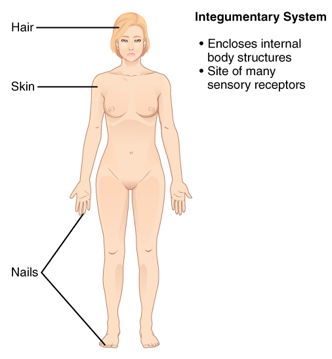
Your skeleton is a structure of living tissue that grows, repairs, and renews itself. The bones within it are dynamic and complex organs that serve a number of important functions, including some necessary to maintain homeostasis.
Bone, or osseous tissue, is a hard, strong supportive connective tissue that forms most of the adult skeleton, the support structure of the body. In the areas of the skeleton where bones move (for example, the ribcage and joints), cartilage, a semi-rigid form of connective tissue, provides flexibility and smooth surfaces for movement. The skeletal system is the body system composed of bones and cartilage and performs the following critical functions for the human body:
EXAMPLE
Different minerals, like calcium, are stored within your skeletal system.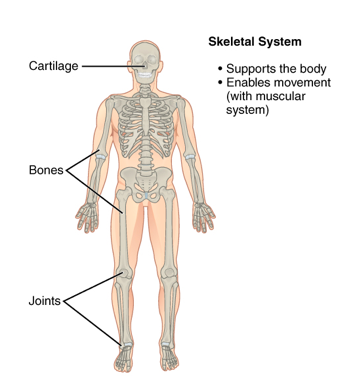
Think about the things that you do each day—talking, walking, sitting, standing, and running. All of these activities require movement of particular skeletal muscles. Skeletal muscles are even used during sleep because the diaphragm is a sheet of skeletal muscle that has to contract and relax for you to breathe day and night.
Your muscular system basically coordinates your movements. It allows for your body to be able to move, and it helps to generate heat for your body to maintain a constant internal temperature; this helps to maintain homeostasis.
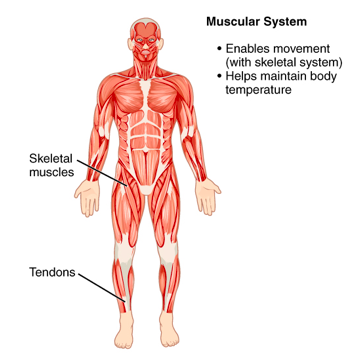
The main role of your nervous system is to detect stimulation in your environment and then control responses to react to that stimulus.
The picture you have in your mind of the nervous system probably includes the brain, which is the nervous tissue contained within the cranium, and the spinal cord, which is the extension of nervous tissue within the vertebral column. That suggests the nervous system is made of two organs—and you may not even think of the spinal cord as an organ—but the nervous system is a very complex structure, with nerves that branch off of the brain and spinal cord. Within the brain, many different and separate regions are responsible for many different and separate functions. It is as if the nervous system is composed of many organs that all look similar and can only be differentiated using tools such as a microscope or electrophysiology.
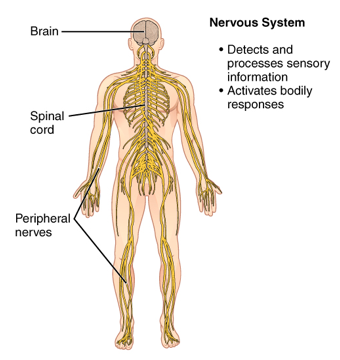
You may never have thought of it this way, but when you send a text message to two friends to meet you at the dining hall at six, you’re sending digital signals that (you hope) will affect their behavior—even though they are some distance away. Similarly, certain cells send chemical signals to other cells in the body that influence their behavior via the endocrine system.
The endocrine system is a chemical messenger system, and its main purpose is to control your body function by producing and secreting chemical substances called hormones. This long-distance intercellular communication, coordination, and control is critical for homeostasis.
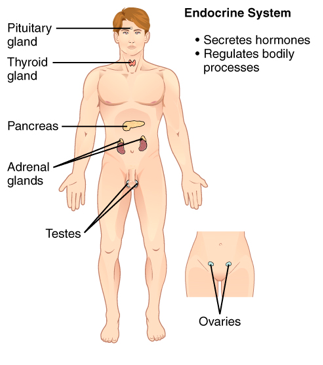
Single-celled organisms can obtain nutrients directly from and excrete wastes directly into their environment. Humans cannot do that. Our large, complex bodies need blood to deliver nutrients to and remove wastes from our trillions of cells.
The main role of your cardiovascular system (also called the circulatory system) is to transport blood and other substances throughout your body. Blood is what carries oxygen, which you previously learned is necessary for human life, and other important materials to the tissues in your body, and it also helps dispose of carbon dioxide waste. The heart pumps blood throughout the body in a network of blood vessels. Together, these three components—blood, heart, and vessels—make up the cardiovascular system.
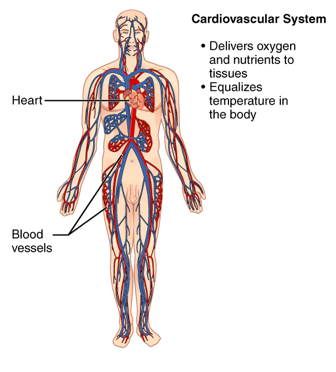
The main role of your respiratory system is to deliver oxygen to your different body tissues and help remove carbon dioxide waste. Carbon dioxide is exhaled and oxygen is inhaled through the respiratory system, which includes muscles to move air into and out of the lungs, passageways through which air moves, and microscopic gas exchange surfaces. Ultimately, oxygen is delivered to blood for distribution to tissues throughout the body.
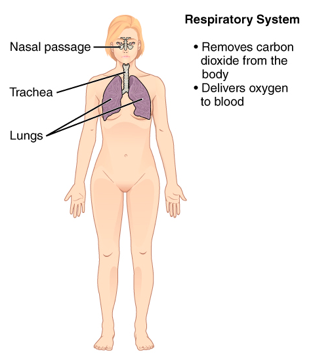
The purpose of the lymphatic system is to collect tissue fluids and then return them to the blood. The immune system is the complex collection of cells and organs that destroys or neutralizes pathogens that would otherwise cause disease or death. However, for most people, the lymphatic and immune systems are associated to such a degree that the two systems are virtually indistinguishable.
The lymphatic system is the system of vessels, cells, and organs that carries excess fluids to the bloodstream and filters pathogens from the blood. It plays a role in your immune system by protecting your body from foreign invaders. For example, the swelling of lymph nodes during an infection and the transport of lymphocytes via the lymphatic vessels are two examples of the many connections between these critical organ systems.
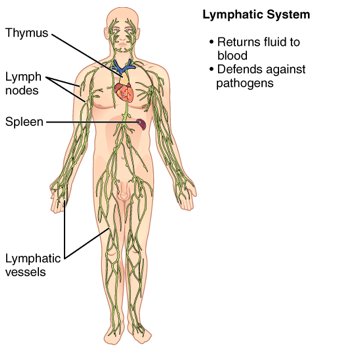
Consider what happens when you eat an apple. Of course, you enjoy the apple’s taste as you chew it, but in the hours that follow, unless something goes amiss and you get a stomachache, you don’t notice that your digestive system is working. You may be taking a walk or studying or sleeping, having forgotten all about the apple, but your stomach and intestines are busy digesting it and absorbing its vitamins and other nutrients. By the time any waste material is excreted, the body has appropriated all it can use from the apple.
The purpose of your digestive system is to ingest and then break down and process foods or liquids that you take into your body. It helps you to intake foods and liquids, digest them, process them, and then get the nutrients from them that you need. Simple nutrients such as carbohydrates, fats, and proteins can then be used by your body for processes such as energy production, growth, and repair.
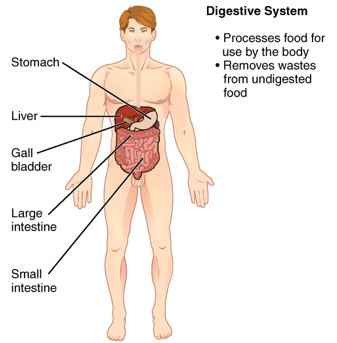
The urinary system has roles you may be well aware of: Ridding the body of extra fluid and wastes as well as cleansing the blood probably come to mind. The urinary system, controlled by the nervous system, is commonly known to store urine until a convenient time for disposal and then provides the anatomical structures to transport this waste liquid to the outside of the body. However, there are additional, equally important functions played by the system that enable physiologic functions critical to homeostasis.
Take, for example, regulation of pH, a function shared with the lungs and buffers in the blood. Additionally, the regulation of blood pressure is a role shared with the heart and blood vessels. What about regulating the concentration of solutes in the blood? Did you know that the kidney is important in determining the concentration of red blood cells? Furthermore, 85% of the erythropoietin (EPO) is produced in the kidneys; EPO stimulates production of red blood cells, which deliver oxygen to tissues throughout the body. The kidneys also perform the final synthesis step of vitamin D production, converting calcidiol to calcitriol, the active form of vitamin D. Each of these functions is vital to your well-being and survival.
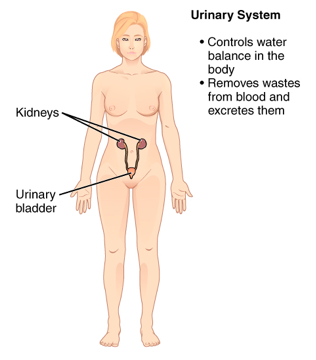
As you previously learned, all living organisms reproduce. In humans, reproduction occurs via the reproductive system.
All of the other body systems are the same for males and females, but the reproductive system differs between the two. Although males and females have different reproductive systems, the basic purpose of the reproductive system is to develop offspring.
When a child is born, it is proof of the healthy functioning of reproductive systems. First, the endocrine system had to secrete the appropriate regulating hormones to induce the production and release of unique male and female gametes (sperm in the testes and oocytes, or eggs, in the ovaries, respectively), which are reproductive cells containing genetic material (one set of 23 chromosomes in humans). Reproductive behavior or medical innovation had to facilitate the transfer of sperm to an egg. Finally, combination of the gametes (fertilization) had to occur, followed by implantation and development in the female uterus until birth. The mammary glands of the female then provide milk to nourish the infant until they are old enough to eat and drink on their own.
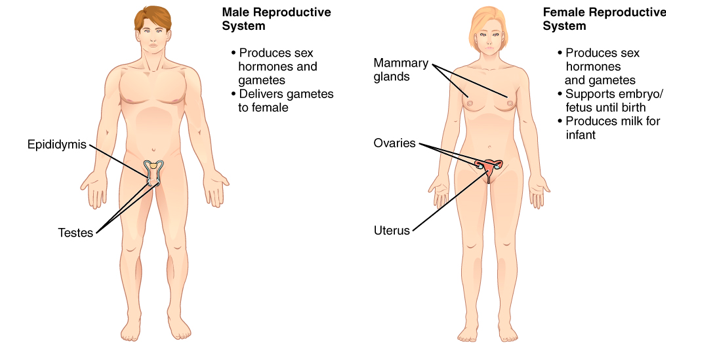
SOURCE: THIS TUTORIAL HAS BEEN ADAPTED FROM (1) OPENSTAX “BIOLOGY 2E”. ACCESS FOR FREE AT OPENSTAX.ORG/BOOKS/BIOLOGY-2E/PAGES/1-INTRODUCTION (2) OPENSTAX “ANATOMY AND PHYSIOLOGY 2E”. ACCESS FOR FREE AT OPENSTAX.ORG/BOOKS/ANATOMY-AND-PHYSIOLOGY-2E/PAGES/1-INTRODUCTION (3) OPENSTAX “CONCEPTS OF BIOLOGY”. ACCESS FOR FREE AT OPENSTAX.ORG/BOOKS/CONCEPTS-BIOLOGY/PAGES/1-INTRODUCTION. LICENSING (1, 2, & 3): CREATIVE COMMONS ATTRIBUTION 4.0 INTERNATIONAL.